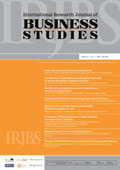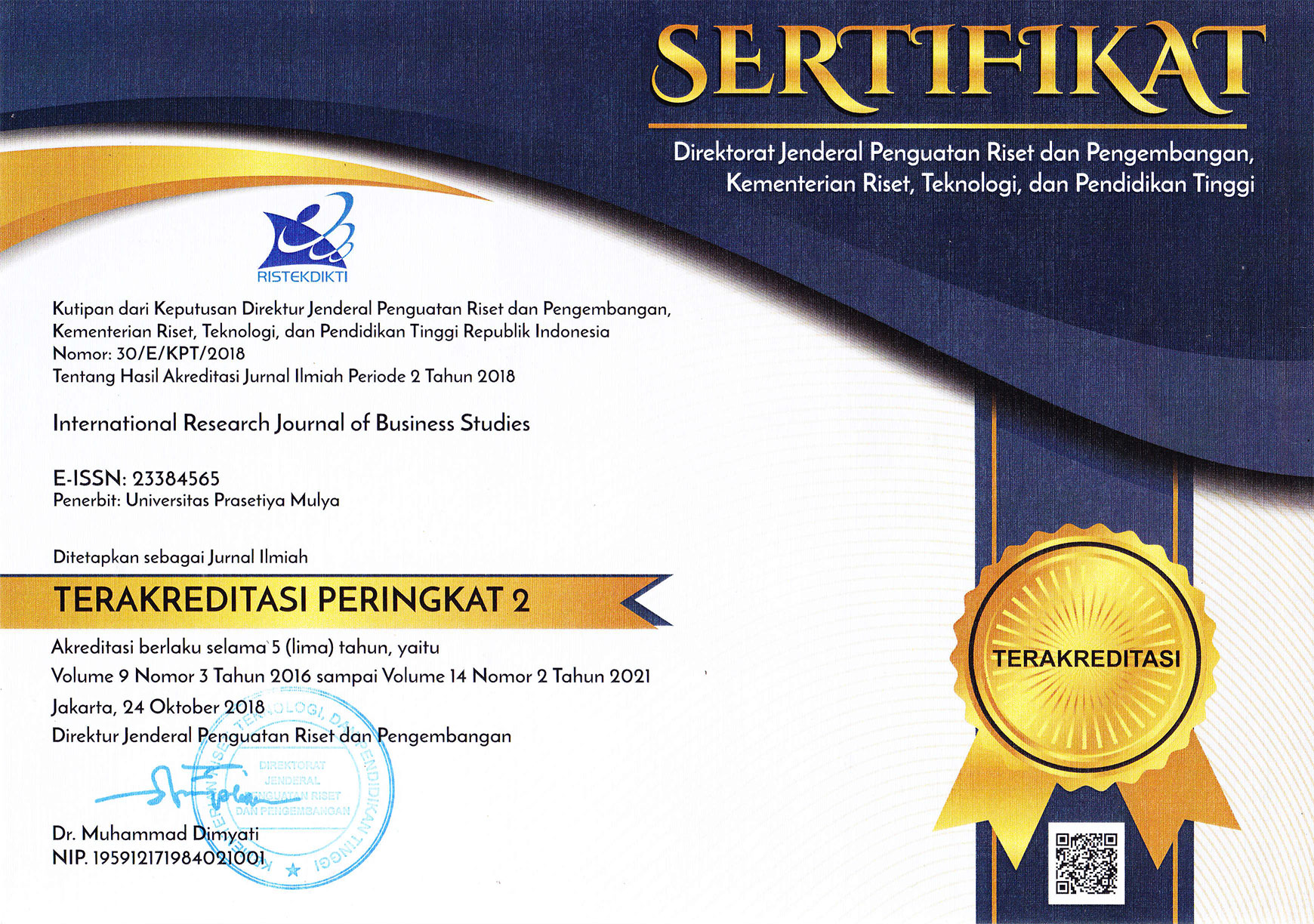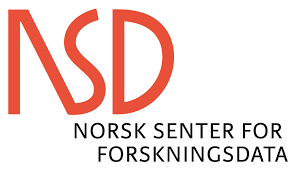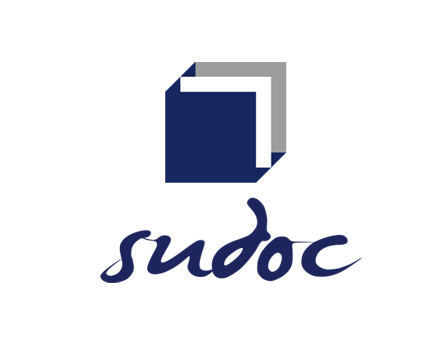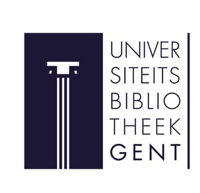Article Metrics |
|
|
Determinants of the Stock Price Volatility in the Indonesian Manufacturing Sector
Abstract
This study aimed to analyze the influence of return on equity, debt to equity ratio, sales growth, firm size, cash ratio, and dividend payout ratio to stock price volatility companies listed on the Indonesia Stock Exchange in the period 2011-2015. The population of this study are all manufacturing companies listed in Indonesia Stock Exchange (BEI) in the period 2011 to 2015. It obtained eight companies samples with technique purposive sampling method. The data analysis technique used is the regression model panel then be adjusted again by using GARCH (Generalized Autoregressive Conditional Heteroskedasticity).The results showed that the volatility of the stock price only have effect without any effect ARCH-GARCH therein. Determining the best models of each prediction is based on estimated volatility GARCH (p, q). The determination of whether there is influence of the factors believed to be the determinants of stock price volatility was done by using panel data regression analysis. The results of panel data regression analysis showed that the company's stock price volatility in the research samples can be explained by 4.84% by ROE, CR, DER, DPR, company size and sales growth while the remaining 95.16% explained by other variables outside the research. Only sales growth has significant positive effect on stock price volatility.
 https://doi.org/10.21632/irjbs.11.3.179-193
https://doi.org/10.21632/irjbs.11.3.179-193
Full Text:
References
Arifin, S. (2014). Pengaruh Profitabilitas, Likuiditas, Growth Potential, dan Kepemilikan Manajerial terhadap Kebijakan Dividen.
Brigham, E. F., & Houston, J. F. (2012). Fundamentals of financial management: Cengage Learning.
Cheng, C. S. A., Lu, C.-S., & Schaefer, T. F. (1996). Earnings Permanence and the Incremental Information Content of Cash Flows from Operations. Journal of Accounting Research, 34(1), 173-181.
Comin, D., & Mulani, S. (2009). A Theory of Growth and Volatility at the Aggregate and Firm Level. Journal of Monetary Economics, 56(8), 1023-1042.
Dong, M., Robinson, C., & Veld, C. (2005). Why individual investors want dividends. Journal of Corporate Finance, 12(1), 121-158.
Drees, B., & Eckwert, B. (2000). Leverage and the Price Volatility of Equity Shares in Equilibrium. Quarterly Review of Economics and Finance, 40, 155-167.
Ernayani, R., Oktiviana, S., & Robiyanto, R. (2017). The Effect of Return on Investment, Cash Ratio, and Debt to Total Assets Towards Dividend Payout Ratio (A Study Towards Manufacturing Companies Listed in Indonesia Stock Exchange). Advanced Science Letters, 23(8), 7169-7199. doi: https://doi.org/10.1166/asl.2017.9328
Ernayani, R., & Robiyanto, R. (2016). The effect of the cash flows, gross profit and company size on Indonesian stock returns (a study on the chemical and basic industry companies during the periods of 2009-2014) International Journal of Applied Business and Economic Research, 14(3).
Ernayani, R., Robiyanto, R., & Sudjinan, S. (2017). Factors influencing profit distribution management of sharia commercial banks in Indonesia. Journal of Economics, Business & Accountancy Ventura, 20(2). doi: 10.14414/jebav.v20i2.1055
Eviani, A. D. (2015). Pengaruh Struktur Aktiva, Pertumbuhan Penjualan, Dividen Payout Ratio, Likuiditas dan Profitabilitas Terhadap Struktur Modal. Jurnal Akuntansi dan Sistem Teknologi Informasi 11(2), 194-202.
Ghozali, I. (2011). Aplikasi Analisis Multivariate Dengan Menggunakan Program IBM SPSS 19. Semarang: Badan Penerbit Undip.
Gill, A., Biger, N., & Tibrewala, R. (2010). Determinants of dividend payout ratios: evidence from United States. The Open Business Journal, 3(1).
Gujarati, D. N. (2003). Basic Econometrics: McGraw-Hill Higher Education.
Gusni, G. (2017). The Determinants of Dividend Policy: A Study of Financial Industry in Indonesia. Jurnal Keuangan dan Perbankan 21(4).
Hanafi, M. M. (2013). Manajemen Keuangan. Yogyakarta, Indonesia: BPFE UGM.
Harahap, S. S. (2008). Analisis Kritis Atas Laporan Keuangan. Jakarta: Raja Grafindo Persada.
Hartono, J. (2015). Teori portofolio dan analisis investasi (10th ed.). Yogyakarta, Indonesia: BPFE.
Haryanto, S. (2016). Determinan Permodalan Bank melalui Profitabilitas, Risiko, Ukuran Perusahaan, Efisiensi dan Struktur Aktiva. Jurnal Ekonomi dan Bisnis, 19.
Hermuningsih. (2013). Pengaruh Profitabilitas, Growth Opportunity, Struktur Modal Terhadap Nilai Perusahaan Pada Perusahaan Publik di Indonesia. Buletin Ekonomi Moneter dan Perbankan.
Joni, & Lina. (2010). Faktor-Faktor Yang Mempengaruhi Struktur Modal. Jurnal Bisnis dan Akuntansi, 12(2).
Jumono, S., Achsani, N. A., Hakim, D. B., & Firdaus, M. (2016). The Impacts of ALMA Primary Variables on Profitability: An Empirical Study of Indonesian Banking. International Research Journal of Business Studies, 8(1).
Kumar, K. B., Rajan, R. G., & Zingales, L. (1999). What determines firm size? Working Paper
Loeis, H. P., & Prijadi, R. (2015). Ambiguity towards Multiple Historical Performance Information Signals: Evidence from Indonesian Open-Ended Mutual Fund Investors. Indonesian Capital Market Review, 7(2), 92-101. doi: 10.21002/icmr.v7i2.4846
Lonkani, R., & Ratchusanti, S. (2005). Complete Dividend Signal. Working Paper.
Mai, M. U. (2017). Mediation of CSR and Profitability on the Influences of GCG Mechanism to the Firm Value. Jurnal Keuangan dan Perbankan 21(2), 253-264.
Margaretha, F., & Rizki, R. A. (2010). Faktor-Faktor Yang Mempengaruhi Struktur Modal Pada Industri Manufaktur di Bursa Efek Indonesia Jurnal Bisnis dan Akuntansi, 12(2), 119-130.
Martikainen, T., Perttunen, J., & Puttonen, V. (1995). Finnish Turn-of-the-Month Effects: Returns, Volume, and Implied Volatility. Journal of Futures Markets, 15(6), 605-615.
Murhadi, W. R. (2011). Determinan Struktur Modal: Studi di Asia Tenggara. Jurnal Manajemen dan Kewirausahaan, 13(2), 91-98.
Nastiti, K. L. A., & Suharsono, A. (2012). Analisis Volatilitas Saham Perusahaan Go Public Dengan Metode ARCH-GARCH. Jurnal Sains dan Seni ITS, 1(1), 259-264.
Nur, T. (2014). Searching for Determinants of Pay or Not to Pay Cash Dividend in Indonesia. Indonesian Capital Market Review, 6(1).
Nuswandari, C. (2013). Determinan Struktur Modal Dalam Perspektif Pecking Order Theory dan Agency Theory. Dinamika Akuntansi Keuangan dan Perbankan, 2(1).
Pujiono. (2002). Dampak Kebijakan Dividen Terhadap Harga Saham Pada Waktu Ex-Dividend Day. Jurnal Riset Akuntansi Indonesia, 5(2).
Putra, M. P. S., Atahau, A. D. R., & Robiyanto, R. (2018). Crossasset class portfolio between gold and stocks in Indonesia. Economic Journal of Emerging Markets, 10(1), 69-81. doi: 10.20885/ejem.vol10.iss1.art8
Raz, K. R., & Amir, M. (2014). A Review of Interaction of Financial Leverage and Investment Opportunities on Dividend Policy. Researcher 4.
Riyanto, B. (2011). DasarDasar Pembelanjaan Perusahaan (4th ed.). Yogyakarta, Indonesia: BPFE UGM.
Robiyanto, R. (2017). Performance evaluation and risk aversion rate for several stock indices in Indonesia Stock Exchange. Jurnal Manajemen dan Kewirausahaan, 19(1), 60-64. doi: 10.9744/jmk.19.1.60-64
Robiyanto, R. (2018). Performance Evaluation of Stock Price Indexes in the Indonesia Stock Exchange. International Research Journal of Business Studies, 10(3), 173-182. doi: https://doi.org/10.21632/irjbs.10.3.173-182
Robiyanto, R., & Puryandani, S. (2015). The Javanese lunar calendars effect on Indonesian stock returns. Gadjah Mada International Journal of Business, 17(2), 125-137. doi: 10.22146/gamaijb.6906
Robiyanto, R., Wahyudi, S., & Pangestuti, I. R. D. (2017). The volatilityvariability hypotheses testing and hedging effectiveness of precious metals for the Indonesian and Malaysian capital markets. Gadjah Mada International Journal of Business, 19(2), 167-192. doi: 10.22146/gamaijb.26260
Rudangga, I. G. N. G., & Sudiartha, G. M. (2016). Pengaruh Ukuran Perusahaan, Leverage dan Profitabilitas Terhadap Nilai Perusahaan.
Rumondor, R., Mangantar, M., & Sumarauw, S. B. J. (2015). Pengaruh Struktur Modal, Ukuran Perusahaan dan Risiko Perusahaan Terhadap Nilai Perusahaan. Jurnal EMBA, 3(3), 159-169.
Saadah, S. (2013). Response Asymmetry in Spillover Volatility: An Empirical Study in the Indonesia and Singapore Stock Market. Indonesian Capital Market Review, 5(2).
Sartono, A. (2001). Manajemen Keuangan Teori dan Aplikasi. Yogyakarta, Indonesia: BPFE UGM.
Setiyono, Tandelilin, E., Hartono, J., & Hanafi, M. M. (2013). Detecting the Existence of Herding Behavior in Intraday Data: Evidence from the Indonesia Stock Exchange. Gadjah Mada International Journal of Business, 15(1), 27-44.
Skinner, D. J., & Soltes, E. (2009). What Do Dividends Tell Us About Earnings Quality. Review of Accounting Studies
Suharli, M. (2007). Influence Profitability and Investment Opportunity Set Against Cash Dividend Policy with Variable Strengthening Liquidity As (Study on Companies Listed on the Jakarta Stock Exchange 2002-2003). Journal of Accounting and Finance, 9(1), 9-17.
Suherman. (2017). Apakah Diversitas Gender Memengaruhi Struktur Modal? Bukti Empiris di Indonesia. Jurnal Keuangan dan Perbankan 21(2), 218-227.
Symeou, P. C. (2011). The firm size - performance relationship: an empirical examination of the role of the firms growth potential. Working Paper.
Taliawo, N., & Atahau, A. D. R. (2007). Beta dan Implikasinya terhadap Hasil Diversifikasi Saham Di Bursa Efek Jakarta. Jurnal Bisnis dan Ekonomi, 14(2).
Taungke, N., & Supramono, S. (2015). Ex-dividend Date dan Perubahan Harga Saham. Jurnal Keuangan dan Perbankan, 19(3).
Triyono, & Hartono, J. (2000). Hubungan Kandungan Informasi Arus Kas, Komponen Arus Kas dan Laba Akuntansi dengan Harga Saham atau Return Saham. Jurnal Riset Akuntansi Indonesia, 3(1).
Tyastari, T. T. D., Rosidi, R., & Saraswati, E. (2017). Dividend Policy and Corporate Value (A Meta-Analysis). Jurnal Keuangan dan Perbankan 21(3).
Utami, M., & Rahayu, M. (2004). Peranan profitabilitas, suku bunga, inflasi dan nilai tukar dalam mempengaruhi pasar modal Indonesia selama krisis ekonomi. Jurnal Manajemen dan Kewirausahaan, 5(2).
Wang, X. (2000). Size Effect, Book-to-Market Effect, and Survival. Journal of Multinational Financial Management, 10, 257-273.
Wang, Y., & Ma, J. (2014). Excess Volatility and the Cross-section of Stock Returns. The North American Journal of Economics and Finance, 27, 1-16. doi: 10.1016/j.najef.2013.10.003
Wijaya, R. (2017). Kinerja Keuangan dan Ukuran Perusahaan terhadap Harga Saham dengan Kebijakan Dividen sebagai Variabel Intervening. Jurnal Keuangan dan Perbankan 21(3).
Wiyani, W. (2005). Pengaruh nilai tukar Rupiah, tingkat suku bunga deposito dan volume perdagangan saham terhadap harga saham. Jurnal Keuangan dan Perbankan, 9(3).
Yusintha, P., & Suryandari, E. (2010). Analisis Faktor-Faktor Yang Mempengaruhi Struktur Modal (Studi Empiris Pada Perusahaan Manufaktur di Bursa Efek Indonesia). Jurnal Akuntansi dan Investasi, 11(2), 179-188.
Copyright (c) 2018 Heny Handayani, Harjum Muharam, Wisnu Mawardi, Robiyanto Robiyanto
International Research Journal of Business Studies has been covered by the following services: | ||||||||||||||||||||||||
|

